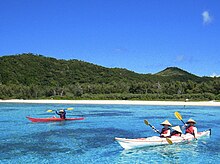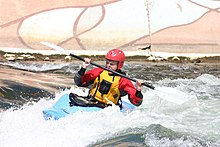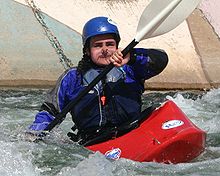Edges (canoe)
Edge , edging or edging referred to in canoeing the controlled generation of a lateral inclination of the canoe. The paddler usually sits upright in the boat. In a canoe that is edged to the right, the right side is slightly raised out of the water, while the left side is a little deeper in the water; Seen from behind, the "upright" axis of the canoe runs from top left to bottom right ("rotation of the [boat] around its horizontal axis to the left"). A left (up) edged canoe lies mirror-inverted in the water.
Edging is one of the most important techniques in canoeing. On the one hand, it is used to steer the canoe. On the other hand, it is used, especially in currents, to regulate the balance so that the boat does not capsize . Edging also plays an important role for figures in canoe rodeo (play boat rides) and squirt boating .
Canoe paddlers, especially solo paddlers, who propel their boat with the paddle mainly on one side, are particularly dependent on tilting techniques to steer and stabilize their boat. Paddlers in whitewater canadians can only intercept the tilting movements of the boat on the active side and, by edging the boat, ensure that the boat can only tilt to the side on which it can be intercepted. In solo paddling techniques such as the Canadian style , the paddler kneels sideways in the boat so that it is constantly in an upright position.
Edging technique
The weight shift for edging is generated by shifting the upper body to the side (slight "kinking" in the hip). At the same time, on the side of the boat that is to be lifted out of the water, the knee ( kayak ) or thigh / leg ( Canadians driven in kneeling position ) is raised. If the type of boat allows it ( sea kayak ), the opposite leg can also be stretched out.
For balance, it is important that the upper body and head are (can) be held straight above the canoe and not just leaned sideways. In order to keep the balance when leaning to the side, lateral support (especially paddle support ) is often necessary. However, leaning can sometimes be useful; This applies to sideways surfing, for example, where the current often affects the canoe so strongly that the weight of the upper body leaning downstream has to be used to keep the canoe canted.
The maximum possible angle when edging depends on the canoe, the water used and the ability of the paddler. Experienced paddlers can often keep their boat canted at 30 °. The stability of the edge is more important than the maximum angle: A paddler who constantly drives his boat e.g. B. can edge to 10 °, has better control and thus maneuverability than a paddler who briefly tilts his boat to 15 °, but cannot hold this position.
Applications of edging
Edging is used for several purposes.
Taxes

To steer, the canoe is tilted slightly "outwards". For a right turn, the left side of the boat is pushed deeper into the water or the right side of the boat is turned up; for a left turn, the right side of the boat is more heavily loaded. Edging is usually used in conjunction with appropriate paddle strokes, especially in smaller boats; For a right turn, paddling is stronger on the left side of the boat than on the right and vice versa.
If a canoe is generally pushed to one side (e.g. by cross wind or uneven weight distribution), a canoe is tilted in the opposite direction to compensate. For example, in the event of a strong wind from the right-hand side, which constantly pushes the canoe to the left, the right-hand side is turned up.
Edging is important for steering, especially for touring canoes with a long waterline and low keel . You drive straight ahead excellently and relatively quickly (directional stability). However, this makes them less maneuverable, which is why edging is particularly important for course changes.
Effect of edging when steering
Edges reduce the length of a canoe's waterline and increase the keel jump, especially on boats with a low keel jump. This makes the edged canoe more maneuverable. In boats with a high keel, canting plays less of a role in steering, since they already have that maneuverability.
In addition, canoes react strongly to the flow of water around the boat's hull . It can be influenced by edges, since the folded side is lifted slightly out of the water asymmetrically, while the other side of the canoe is pushed deeper into the water and its area increases. On the canted side of the boat there is thus a smaller surface area of the boat hull under water than on the lower side of the boat. This difference varies depending on the shape of the hull (e.g. relatively steep or flat sides of the boat), but in principle it has the same effect: a hydrodynamic angular momentum is created that drives a forward-going, right-edged canoe into a left turn and vice versa.


Edges in currents
In currents, the side of the boat facing the current is turned up. This prevents the current from flowing over the deck of the boat, pushing it underwater and capsizing the boat .
Strictly speaking, this is always the current relative to the canoe or, to put it another way, the difference in speed: If the boat enters the current from calmer water, the upstream side of the boat must be canted accordingly. If, on the other hand, the canoe travels in a fast current and is to be steered into calm flowing water, this water "moves" upstream relative to the boat - accordingly, it must be canted downstream. A greater flow difference must be compensated for by comparatively greater edges; however, very slight differences in flow can be ignored.
The same principle applies when crossing currents by cable ferry . In the case of the cable ferry, the opposite side is not stopped in a straight line, but approached at an angle against the current in order to compensate for all or part of the downforce caused by the current. As a result, there is again a flow difference between the canoe and the (incoming) water, which is why you have to tilt upstream again.
When surfing (see Kanurodeo ) the edge is used accordingly and on the side of the approaching water, i. H. on rollers and standing waves usually upstream, canted. This is the case with both forward surfing (upstream) as well as backward (downstream) and sideways surfing. When surfing, the edging can also be used for steering: As in shallow water, the boat “turns around” its lower side, which is particularly useful for carving, in which the paddler edges the boat relatively steeply upstream.
Edges for figures
For toy boat drivers and squirt boaters who drive figures with their canoes, weight shifting and edging play a central role. Reliable edging is one of the basic requirements for straightening a boat on the stern or bow in shallow water . Edging is also necessary for some of the figures in which the surfing paddler briefly throws his boat and himself into the air and, for example, turns around its axis ( aerial moves ).
See also
Individual proof
- ↑ a b c d Udo Beier (January 6, 2009). Edge. An often neglected paddling technique component. (PDF file; 48 kB) at www.kanu.de (accessed April 7, 2009)

